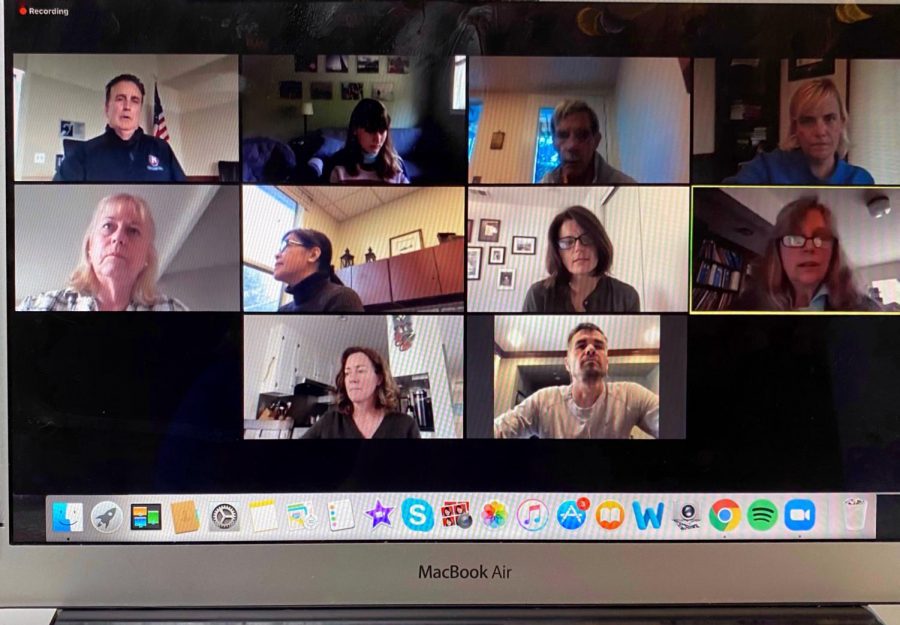Grading Policy Shift Proves Controversial
April 7, 2020
The Acalanes Union High School District (AUHSD) announced on March 23 that, in light of the global coronavirus pandemic, 2nd-semester grades will be recorded as “credit” or “no credit,” rather than as a traditional letter grade.
The announcement, which was emailed to all families in the district, added that “AUHSD staff may need to respond by changing the [updated] grading guideline based on new CDE [California Department of Education] or federal guidance.”
1 of these potential changes is “the possibility of providing students with a choice of selecting their 3rd Quarter grade or Credit (CR) at the end of the Second Semester if they successfully completed all distance learning work,” the email said. 4th quarter grades, however, will be recorded as credit/no credit.
According to Associate Superintendent Aida Glimme, the decision was “based on the issues of equity at home” as well as “how the distance learning material is accessed” and the “tremendous stress and challenges” that students are experiencing. In addition, teachers are unsure if tests and assignments are assessing students’ ability to access material, navigate it independently, or understand the curriculum. There is also an issue with academic integrity.
“Due to all of those things, we felt, just like the other districts and the guidance of the CDE, that we are not supposed to be implementing summative assessments and our assessments are supposed to be formative, meaning that we give feedback to students on what they’re supposed to be learning, without doing summative assessments – altogether, that led us to this decision, that it should be credit/no credit for the time while we’re closed in school,” Glimme said.
In order to receive credit at the end of the semester students must “demonstrate that they are learning the material, engagement, effort and mastery to a degree,” said Glimme. However, Glimme added that “courses with No Credit get a 0 GPA which is a huge factor.”
The district received a considerable amount of feedback from parents, prompting them to release another statement on March 24.
“At this time, we are receiving early indications that colleges/universities will regard 2020 second semester grades with an asterisk, with very limited consideration, recognizing the disparate hardship students and families encountered during one of the most broad-scale disruptive periods in recent secondary education history,” Glimme wrote in the statement.
According to Glimme, most colleges and universities are also moving to a credit/no credit system, just as the AUHSD has implemented, or a credit/no credit system with some option of a letter grade.
The AUHSD announced that it was holding a Governing Board meeting via Zoom, a video-conferencing platform, on March 27. Students and parents were invited to tune in. The district provided families with a Google Form link to provide input on the grading policy.
According to Governing Board member Nancy Kendzierski, the district received “significant public comment,” including 118 responses to the Google Form by 4:00 PM the day of the call.
Prior to the meeting, a petition letter circulated amongst AUHSD families urging the district to “offer the students a CHOICE between credit/no credit or a [2nd] semester letter grade that uses their [3rd] quarter grade as a floor, such that the students can improve their grade with their [4th] quarter work, mirroring the policies of many high school districts and universities,” according to the petition.
As of 1:00 PM on March 27, the letter had over 350 signatures from families around the district.
At the Governing Board meeting, Superintendent Dr. John Nickerson read public letters from teachers, students, and parents. The letters included both comments supporting the new policy and comments criticizing it.
1 such letter, from the Acalanes Education Association president Lori Tewksbury of Acalanes High School, said, “Students are not getting the learning experience they would’ve had in the classroom. That’s why letter grades would be disingenuous at best. A letter grade for 4th quarter distance learning would not be the same as a letter grade the student would earn in the classroom. They can’t be. That’s why credit/no credit for the 4th quarter is necessary. We don’t like it, but it’s a true indicator of what we are able to do under the current circumstances.”
Statements favoring the credit/no credit system included the fact that some classes have just 1 or 2 assignments in certain categories, which makes them worth more than any final exam, the difference being that students did not know the weight of that particular piece of work. They also noted that, if students have the ability to choose between a letter grade and credit/no credit, students applying to college with letter grades on their transcripts may have an unfair advantage over those who choose credit/no credit instead.
Opposing arguments indicated that students’ work in the 3rd quarter would have essentially been done for nothing and that students will be unmotivated to do schoolwork during the 4th quarter. The opposition also noted that the policy may negatively impact students in the college application process.
According to Nickerson, however, institutions like Stanford University and Harvard College have already demonstrated that they will accept credit/no credit marks on transcripts, as have other colleges, like DePaul University and the University of Southern California.
The California State University (CSU) and University of California (UC) systems announced on March 31 and April 1, respectively, that they are suspending letter grade requirements for A-G courses (required courses, like English and math) completed during spring 2020 for all students.
“UC and CSU – so many of our students go to those [schools],” said Nickerson. “The conventional wisdom in the state is that they will absolutely come out with pass/no pass or credit/no credit is absolutely okay and will not be held against any student applicants.”
Nickerson acknowledged the argument from students and parents that, although credit/no credit won’t be held against students, it will not improve their GPAs because they won’t receive As in their AP classes. But, “[colleges] understand that,” said Nickerson.
Another petition, which was sent out to families via the Change.org platform, began circulating in early April. As of April 4, the petition had 728 families’ signatures. It called for the district to provide students with the option of choosing credit/no credit or letter grades based on 3rd quarter grades with the opportunity to improve them with 4th quarter work.
Student reactions to the district’s new grading policy gathered via La Puma’s Instagram account were varied. 1 student said, “not doin [sic] any work for the rest of the year,” while another exclaimed, “hallelujah.”
Another respondent said, “such a WIN for the seniors tho [sic].”
Not everyone was thrilled with the decision, however. The disappointment was expressed from 1 student who said, “awful for my GPA,” while another student noted, “terrible…I feel like all my motivation is gone now.”
In response to a La Puma Instagram poll, 68% of respondents said they would like to choose between having their 3rd quarter grades and credit/no credit recorded on their transcripts.
“I don’t want my grades to be indistinguishable from someone who got straight Cs,” 1 student responded.
“I have to admit, I was a bit disappointed and shocked when I heard that 3rd quarter grades may not be included in 2nd-semester grades, and we were switching to a credit/no credit system,” said junior Noel Seo. “But due to the gravity of the pandemic we’ve switched to distance learning, and we’ll have to accept changes in the grading system as well.”
Seo said that she would prefer to choose between using 3rd quarter letter grades and credit/no credit. “I think that the [credit/no credit] system is too vague and offers little information about a student’s proficiency in a class, especially on a record where he/she received letter grades in the past,” she said. “I understand that the third quarter cutoff might be considered unfair to some students, but in terms of accuracy, mid-semester grades should be an accurate indicator of how well a student is doing in the class.”
Campolindo parent Malaika Stoll agreed. “I believe there should be a choice. This is an unprecedented situation and everyone will face slightly different challenges, so giving a choice – yes, I want grades to count or no, [I] want [pass/fail] – makes sense,” she said.
Stoll signed the aforementioned petition. “Having 3 school-age children at home, I see that they need activities to focus on during this time. It’s a great time to study as there are less distractions available to them. So having school online and giving them the motivation to perform in school (grades) is, I believe, helpful,” she said.
Sophomore Lexi Fok said that she doesn’t “have a super strong opinion” and acknowledged that both systems have their benefits. “I think that [credit/no credit is] good in that it’s an easier grading system for students and teachers while we have to stay at home and try distance learning but I also understand why some people want to keep a point grading system,” she said.
Both Seo and Fok don’t believe that the grading system will be very influential in the college application process. “This is happening everywhere and it’s not a choice we can make,” said Fok.
Seo added, “This time for juniors is supposed to be 1 one of the most rigorous regarding academics and extracurriculars, but since most schools across the country have transitioned to online learning or are in worse circumstances due to COVID-19, colleges probably will not be putting too much emphasis on this time when considering whether to admit a student.”
“I think that it’s hard for the schools to make a grading system that is ideal for everyone so we have to be [okay] with whatever happens,” said Fok.
“With or without grades I hope students will stay safe during this time and use it to learn and grow,” said Stoll. “Read, write, take online courses, learn a new language, or to cook, sew, or whatever you maybe wanted to do but didn’t have the time.”

